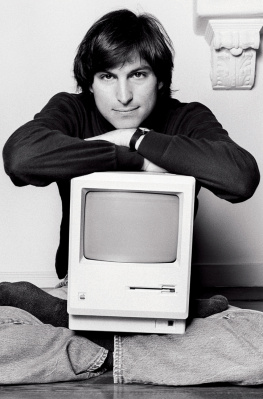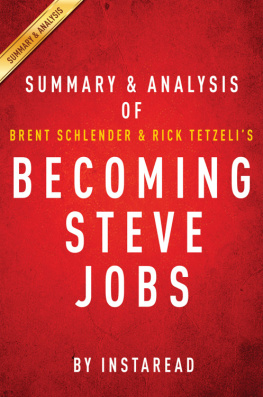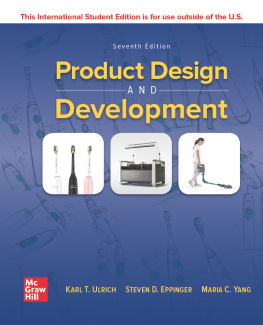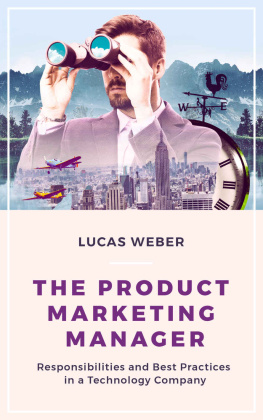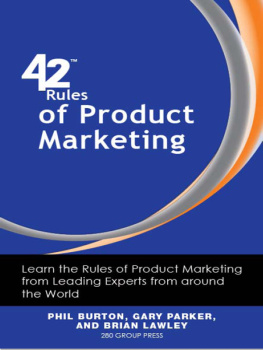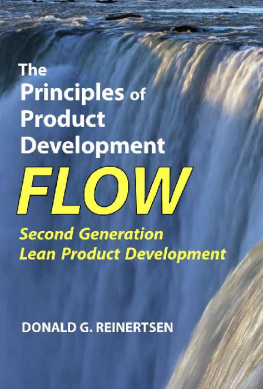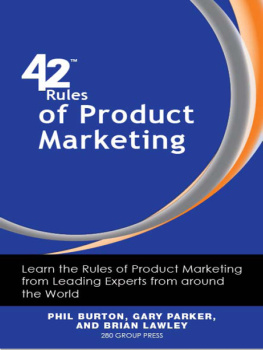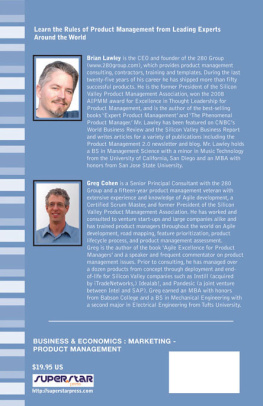
Table of Contents
For my wife Liliana,
and my sons Jay-Alexander
and Federico for their loving support
And for Arynne, Victoria, and Charlotte,
and Sheldon, Vincent, and Elena
Authors Note
Sometimes Things Happen...
... that turn out so well we couldnt have improved on them if wed mapped out our own lives in advance.
Of course, what are called the glamour jobsthe movies, television, the music business, fashionoften only seem glamorous from the outside: Working in one of those fields is fraught with constant challenges and frustrations.
Hardly anyone thinks of technology as a glamour field, but for me, at least, work has never been as satisfying or as unbelievably exciting as when I was working with Steve Jobs.
Because its awkward to write products and services throughout, I have instead used just productcounting on you to understand that the term is intended to include services, as well.
Ive known and worked with the leaders of IBM and Intel; Ive met great leaders and thinkers, including Jack Welch, Buckminster Fuller, and Joseph Campbell, and discussed the next paradigm change in organizational structure with John Drucker.
Steve is in a class by himself.
The major business journals often disagree, yet there is a consensus that Steve Jobs is the leader of the most outstanding company in the history of business. Steve does seemingly impossible things, every day.
So what is it that has made Steve so unique in the ways he runs an organization that brings such convenience, time-saving, and pleasure to so many people around the world? Thats the question I have set out to answer here.
This is not only about how you shift your paradigm, but how you get your organization to shift with you. The principles of iLeadership presented here offer the key elements involving the product or service you offer, the people and teams, the organization itself, and the innovation engine to connect what you do and what you make with the customers you are trying to reach. Steve Jobs provides probably the best example possible of how a leader can implement these changes and run even a very large organization as if it were in start-up mode.
Some of the advice I give will not seem easy or comfortable. I will ask you to think in ways that you are not used to. But you can improve your business and your life if you are courageous enough to carry out the iLeadership principles you will find in these pages.
Jay Elliot
Prologue
I was sitting in the waiting area of a restaurant...
... which has to be one of the most unlikely places in the world for an encounter that changes your life.
The headline story I was reading in the business section told about the calamitous end of start-up Eagle Computer. A young man who was also waiting was reading the same article. We fell into conversation and I shared my connection with that story. I had just recently told my boss, Intel president Andy Grove, that I would be quitting my position at his company to join the guys who were starting Eagle Computer. The company was just about to go public.
The day of the public offering, the CEO became an instant multimillionaire and celebrated by going out drinking with his cofounders. From there he drove right over to buy himself a Ferrari, took a car from the dealership for a happy test drive, and crashed. He died, the company died, and the job I had quit Intel to take was over before I had even reported for work.
The young man I had told this story to started asking questions about my background. We were quite a contrast: He was this hippielooking twenty-something in jeans and sneakers. In me he saw a six-foot-five athlete in his forties, a corporate type in suit and tie. About the only thing we seemed to have in common was that at the time we were both wearing beards.
But we quickly discovered a shared passion for computers. The guy was a fire-eater, bursting with energy, lighting up at the idea that I had held key positions in technology but had left IBM when I found them slow to accept new ideas.
He introduced himself as Steve Jobs, Board Chairman of Apple Computer. I had barely heard of Apple, but I had trouble seeing this youngster as head of a computer company.
Then he took me entirely by surprise, saying hed like me to come work for him. I answered, I dont think you can afford me. At the time, Steve was twenty-five and later that same year, when Apple went public, would be worth something like $250 million. He, and the company, could afford me.
On a Friday two weeks later, I started working for Appleat a slightly higher salary and with many more stock options than I had had at Intel, and with a parting message from Andy Grove that I was making a big mistakeApple isnt going anywhere.
Steve likes to surprise people by not sharing information until the last minute, maybe as a way of keeping you a little bit off balance and a little more under his control. My very first day on the job, at the end of an afternoon get-to-know-each-other-better chat, he said, Lets take a ride tomorrow. Meet me here at ten. I want to show you something. I had no idea what to expect or whether I should be preparing myself in some way.
Saturday morning we got into Steves Mercedes and drove off. Music was blaring out of the cars speakers: the Police and the Beatles, uncomfortably loud. Still no word of where we were heading.
He pulled into the parking lot at PARC, the Xerox Palo Alto Research Center, where we were ushered into a room of computer equipment that blew me away. Steve had been there a month earlier with a group of Apple engineers, who had been divided about whether the goodies they had seen would amount to anything of value for personal computers.
Now Steve was back for another look, and he was on fire. His voice changes when he sees something insanely great, and I witnessed it that day. We saw a crude version of a device wed later call a mouse, a computer printer, and a computer display that wasnt limited to text and numbers but could show drawings and graphic images, and menu items you could select with the mouse. Steve talked afterward about those PARC visits as apocalyptic. He was sure he had seen the future of computing.
PARC was creating a machine for the enterprise, a mainframe computer to compete with IBM, expected to carry a price tag of $10,000 to $20,000. Steve had seen something else: a computer for everyone.
But he hadnt just seen computer technology. Like a boy in Middle-Ages Italy who entered a monastery and discovered Jesus, Steve had just discovered the religion of user-friendly. Or maybe he had already had the lust and had just now discovered that there was a way to satisfy it. Steve the ultimate consumer, Steve the envisioner of product perfection, had stumbled upon the shining path to a glowing future.
Sure, it wasnt going to be a smooth path. He would make a lot of grievous, costly, near-disastrous mistakes along the waymany of them because of a sense of his own infallibility, the kind of stubborn certainty that gave rise to the clich, my way or the highway.
But for me, his newly acquired sidekick, it was awesome to see how open he was to possibilities, how excited he was about recognizing new ideas, seeing their value, and embracing them. And his enthusiasm is infectious. He understands the mind-set of the people he wants to create products for because he is one of them. And because he thinks like his future customers, he knows when he has seen the future.
I would come to see Steve as incredibly bright, overflowing with enthusiasm, driven by a vision of the future, but also incredibly young and wildly impulsive. How did he see me? As something I believe he had been looking for and hadnt yet found. In me, he finally had a senior guy who had a solid grounding in business. Though my new title was senior vice president of Apple Computer, Inc., the job came with unofficial duties as Steves sidekick, mentor, and graybeard (I was forty-four years old). Before long he would be telling people, Dont trust anyone over forty except Jay.
Next page

